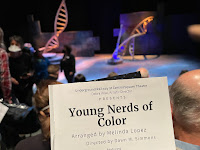 |
| A velvet creosote bush two miles from the U.S.-Mexico border. |
Deserts are miraculous places. Constant reminders of how much suffering exists within and alongside beauty.
The southern borderlands' dry clear light and relentless winds tattoo us, exfoliating potential tears and sweat from skin. Sitting quietly, we become the busyness of acorn woodpeckers, yellow-rumped warblers, lesser goldfinches, Mexican jays, a whole host of diverse hummingbirds. Jumping chollas, saguaros, flowering yuccas and creosote create vast expanses and palettes of color.
These dualities seem even greater here in the U.S.-Mexican southwest, what Gloria Anzaldúa identified in 1987 as Borderlands/La Frontera. Subtitled The New Mestiza, this book was and is iconic to me as a queer, adopted person. It is a layered work of prose and poetry, dream and theory and identity, built on Anzaldúa's life as a Chicana, lesbian, activist and writer to remap the ways we understand false physical "borders" of nation into the psychic and cultural worlds in which we are alive together (see the new critical edition released in 2021 by Aunt Lute Books. I was lucky to interview Gloria in 1989 when I wrote about this book for a special edition of TRIVIA, A Journal of Ideas I co-edited with Lise Weil.).
First day in the borderlands, driving our rented gray Dodge Challenger "muscle car" we call "The Ghost" and jokingly referring to ourselves as Starsky and Hutch, we were pulled over by Border Patrol. The car does have a certain "look" that might in some minds contradict our own "look" of old lady white privilege. Our GPS had us turning in circles as we emerged from a birding preserve in a canyon where, it turned out, BP had been running an "immigration operation" for a couple of weeks.
They searched our trunk.
 |
| My generous partner in crime (Hutch) with "The Ghost." |
This beautiful, painful, arid place, where the Sierra Madres meet the Sonoran Desert, is a good place to find myself mid-Lenten season. According to the christian bible, Lent represents the part of the liturgical year in which Jesus fasts in the desert for 40 days, at the end of which, starving, he is tempted by the devil. Satan does his best to lure Jesus with the rewards white America loves best: reputation, power, possessions.
Birdwatching in the desert during Lent: intentionally stripping away distractions from suffering and reflecting on the beauty of our connections. What are your primary distractions? Social media? Food? Love and affection and sex? Work? Wealth? Privilege? Accumulation?
Like the vermillion flycatchers darting ceaselessly above the San Pedro river to feed themselves, or the hummingbirds who eat all day long, work is both my primary distraction and connections.
 |
| A vermilion flycatcher, one of many perched along the San Pedro. |
It's as impossible to ignore the green-striped border patrol trucks at the mouth of practically every wash, the proliferation of state troopers in the medians, as it is the brightly colored birds. Law enforcement is heavy here, where the U.S. has built walls and fences across the frontier over which indigenous peoples once migrated freely. Where we attempt to keep out those suffering from the violence and starvation of our own banana republic policies and actions.
Nationalism, punishment, greed, a lack of mercy -- these are the sins of our national culture against the world we've been given to steward and to share. As a nation, have we failed these crucial tests?
And still, like birds: how can we keep from singing. For justice. For love.
#vermilionflycatcher
#riparian
#lafrontera
#borderlands
#newmestiza
#newblogpost










